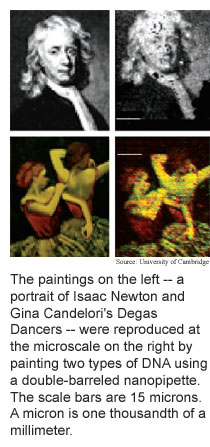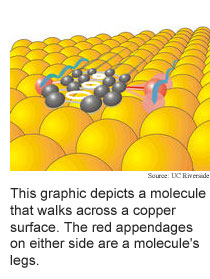
Week
of October 31, 2005
Double-barreled
nano printing
The ability to precisely position tiny amounts of DNA and other
biological molecules is becoming increasingly important in studying diseases,
finding new drugs and diagnosing illness. It is also key to the emerging
practice of making nanoscale devices from biomolecules.
 One challenge is figuring out how to rapidly deposit microscopic amounts
of two or more substances in the same place.
One challenge is figuring out how to rapidly deposit microscopic amounts
of two or more substances in the same place.
Researchers from the University of Cambridge and Imperial College
London in England have addressed the problem with an electrically controlled
double-barreled
nanopipette that can precisely place tiny amounts of two different
biomolecules onto a surface.
They demonstrated the the device's fine control by making microscopic
reproductions of paintings.
The barrel openings measure as small as 140 by 100 nanometers.
Electrical voltage -- one barrel positive and the other negative -- causes
biomolecules to flow out of one barrel. When the voltage is reversed biomolecules
flow from the second barrel. The device deposits dots of material as small
as 350 nanometers in diameter, which is about 15 times smaller than a
red blood cell.
The advantage of the double barrels is being able to deliver two
substances to the exact same spot, without having to precisely position
a second nanopipette.
The technique could be used with more than two barrels; current
fabrication methods make as many as seven.
(Two-Component Graded Deposition of Biomolecules with a Double-Barreled
Nanopipette, Angewandte Chemie International Edition, published
online October 25, 2005)
Security through obfuscation
In the world of computer security the name of the game is access,
or more specifically preventing access. If you don't have the right password
and/or certificate and/or token, you can't get in the door.
Researchers from the University of Texas at Austin are trying
a different approach -- obfuscated
databases and group privacy. Under their system, anyone can get in
the door, but you can only get information that you already know something
about.
A database query, for instance, consists of some piece of information
unique to the record sought. For example, plugging in your name and frequent-flier
number would allow you to retrieve a statement of your frequent-flier
miles. But instead of using your name and number as part of an authentication
scheme -- to prove that you are you -- they are simply part of the database
record itself.
This removes the need for an authentication mechanism to maintain
(and protect) every user's name and frequent-flier number. The system
is secure because it is virtually impossible to guess the astronomical
number of combinations of names and numbers, even with a very powerful
computer.
(Obfuscated Databases and Group Privacy, 12th ACM Conference on
Computer and Communications Security (CCS 2005), November 7-11, Alexandria,
Virginia)
Better light switches
A pair of research papers promises improvements in optical modulators,
the light switches that encode data into light beams for data communications.
One could lead to a 100-fold speed up of telecommunications and the other
provides a relatively inexpensive way of building optical modulators into
silicon computer chips.
Researchers from the University of California at Santa Barbara,
NASA and the Georgia Institute of Technology used a powerful electric
field to push a quantum well optical modulator to nearly 4 terahertz,
or trillion times per second. Quantum wells are made of extremely thin
layers of semiconductor that confine electrons to a plane.
At such high frequencies relatively low-power communications-wavelength
light beams can be used to control each other, opening the way for much
faster data flow through fiber-optic communications lines.
Meanwhile, researchers from Stanford University and Hewlett-Packard
Laboratories have made an optical
modulator from a stack of multiple quantum wells made from relatively
inexpensive silicon and germanium. Existing similar devices use more expensive
compound semiconductors that are not easily integrated with silicon computer
chips.
This second advance promises cheap, miniaturized communications
devices like the switches that route traffic in telecommunications networks.
(Quantum Coherence in an Optical Modulator, Science, October
28, 2005 and Strong Quantum-Confined Find Stark Effect in Germanium Quantum-Well
Structures on Silicon, Nature, October 27, 2005)
Molecule walks this way
Scientists making molecular-scale mechanical devices have been
mining the past for ideas. This makes sense because things move much faster
at the molecular scale. The enhanced speed opens up new possibilities
for mechanical computation devices like the ancient abacus.
 Researchers from the University of California at Riverside and
Kansas State University have created a two-legged
molecule that can walk in a straight line on a flat copper surface
without a track.
Researchers from the University of California at Riverside and
Kansas State University have created a two-legged
molecule that can walk in a straight line on a flat copper surface
without a track.
The structure of the molecule ensures that only one leg at a time
is in contact with a surface, and as the leading leg lands the trailing
leg lifts from the surface and swings forward. Copper is a crystal, and
a copper surface has three directions of symmetry, or orientations where
copper atoms line up. Energy supplied by a heat source or a nudge from
microscope probe starts the molecular walker (representing an abacus bead),
which then follows one of these directions of symmetry (representing an
abacus line).
Armies of the molecular walkers could be used to store large amounts
of data in relatively small spaces or to do blazingly fast abacus-style
computation.
(Unidirectional Adsorbate Motion on a High-Symmetry Surface: "Walking"
Molecules Can Stay the Course, Physical Review Letters, October
14, 2005)
Bits and pieces
A study
shows that attaching molecules to the outsides of single-walled carbon
nanotubes make the tubes less toxic to cells; a molecular
motor attached to a surface spins in only one direction; a carbon
nanotube field-effect transistor brings spintronics a step forward.
RSS Feeds: News Blog Books New: TRN's Internet Services TRN's Jobs Center News: Research News Roundup Research Watch blog Features: View from the High Ground Q&A How It Works Buy an ad link |
|
| Advertisements: |
|
Ad links: Clear History
Buy an ad link
|
TRN
Newswire and Headline Feeds for Web sites
|